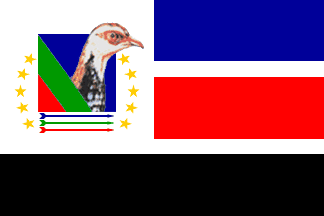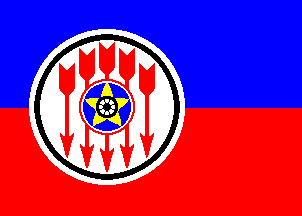Pedro Buccellato, 01 Dec 2002
RENAMO - new emblem
rnm.gif) image from this
website, reported by Gary Selikow, 17 Dec 2001
image from this
website, reported by Gary Selikow, 17 Dec 2001

Last modified: 2014-06-21 by bruce berry
Keywords: renamo | mozambique |
Links: FOTW homepage |
search |
disclaimer and copyright |
write us |
mirrors
 image
by António Martins-Tuválkin, 05 Aug 2008
See also:
image
by António Martins-Tuválkin, 05 Aug 2008
See also:
The Mozambican National Resistance Movement (Resistencia Nacional Mocambicana
or RENAMO) was formed in 1976 by the then Rhodesian
military forces. Rhodesia's white minority government feared that the
Marxist regime
in newly independent Mozambique (under Front for the Liberation of
Mozambique – FRELIMO) would support the guerillas fighting to overthrow the
Rhodesian regime. To pre-empt this possible interference, Rhodesia
created RENAMO to operate against the FRELIMO government, thus continuing the
civil war.
The Rhodesians created RENAMO from disenchanted FRELIMO ex-combatants,
opponents of the Marxist FRELIMO regime and former soldiers of the
former Portuguese colonial army. Most members were Ndau speakers from
the East-Central provinces of Mozambique.
RENAMO's sponsorship changed in 1980 following Zimbabwe's independence.
South Africa then took control of the group and used it to
continue to destabilize
Mozambique, essentially as a punishment for the FRELIMO regime's support
of the African National Congress (ANC) which was then
still fighting the minority government of South Africa. In line with apartheid South
Africa's aim of destabilizing the frontline states, RENAMO focused its
attacks on the communications and trade infrastructure of Mozambique and
Zimbabwe, including railways, pipelines and roads. Forced to
reconsider its support for the ANC due to the brutal tactics of RENAMO, Mozambican President Samora Michel signed the Nkomati Accord
of 1984 with South Africa, which pledged to end Mozambican support for
the ANC in return for an end to South African support for RENAMO.
South African commitment to the accord was questionable, however, and
the violence and civil war in Mozambique continued.
Despite a drop in support from South Africa, RENAMO's
reign of terror continued throughout the 1980s, reportedly killing at
least 100 000 people and creating at least 1 000 000 refugees. Particularly
hard hit were Mozambique's railways, and the government had to
bring in foreign troops to protect from RENAMO attacks. The
combination of these attacks, the government's failed Marxist
policies, and natural disasters led to Mozambique's economic and
social deterioration. These pressures on the Mozambique government led
to governmental reform and the expansion of the political process to
other parties. RENAMO's armed insurgency against the FRELIMO regime
officially came to an end on October 4th, 1992, when the two groups
signed a peace accord, formally ending the civil war.
Despite continuing disagreements over the implementation of the peace
accord and the integration of RENAMO into the Mozambican political
process, the disarmament of RENAMO progressed in the early 1990's with
the help of the United Nations, and thousands of its fighters were
integrated into the Mozambican Armed Forces. RENAMO finally
participated in nationwide elections in 1994, gaining 37.7 percent of
the vote and maintaining a generally regional base of support in the
North and Central regions. Despite periodic complaints of violent
voter fraud and intimidation, RENAMO appears to have now successfully
transformed into solely a political organization. (Source: http://www.tkb.org/Group.jsp?groupID=314
with additional information at: http://en.wikipedia.org/wiki/Renamo).
Esteban Rivera, 09 Mar 2006
The current flag of Renamo consists of three horizontal stripes of dark blue,
red and black separated by thinner white stripes and a white square canton. The
flag specs seem to be approx. (4+1+4+1+4):(10+11) = 2:3. In the canton is
the logo of the party, as described and illustrated below, together with ten
gold stars (five on each side of the logo) as seen on the party's official
website at
http://www.renamo.org.mz/images/banner.gif.
António Martins-Tuválkin, 05 Aug 2008
 image
by António Martins-Tuválkin, 21 Sep 1997
image
by António Martins-Tuválkin, 21 Sep 1997The original flag of RENAMO (Resistëncia Nacional Moçambicana, the
main opposition
party in Mozambique is horizontal 5:7
blue over red bicolour, with a large (5/7 hoist diameter) white circle placed
at the same distance from the hoist and the top and bottom borders. In
the circle, which has a white and black fimbriation, are five large arrows
pointing downwards (the middle one larger than the side ones) and in the center
a blue circle, fimbriated in red and white, is a 5 pointed
yellow star charged with a smaller black circle charged itself with a
ring of 8 white sectors. The five arrows are said to be based on the colonial
arms.
António Martins-Tuválkin, 21 Sep 1997
"The Five Arrows" on the Renamo Flag do not come from the colonial arms as suggested by Antonio Martins but from the handle of a Beretta automatic pistol (see the logo of Beretta at http://www.beretta.it/).
The flag was designed in Johannesburg circa 1975/6. The flag was needed for a fund raising campaign
and under
pressure by the printers a couple of the guys sat down and came up with
the "insignia" to assemble over the red and blue stripes. The red was for the blood
that would have to be shed to regain freedom and the blue stands for the great
African sky - as described by Jardim (the funder of the original Mozambique National Resistance
(MNR) (later Renamo) in his book.
Pedro Buccellato, 01 Dec 2002
RENAMO - new emblem
rnm.gif) image from this
website, reported by Gary Selikow, 17 Dec 2001
image from this
website, reported by Gary Selikow, 17 Dec 2001
It is interesting to note that the arrows from the original emblem used in
the colonial period keep appearing. There are now only three arrows
whereas the previous
flag had five which I believe are derived from the colonial
arms showing St. Sebastian's bunch of seven arrows.
António Martins-Tuválkin, 17 Dec 2001